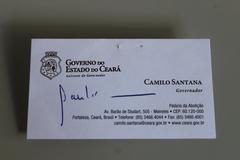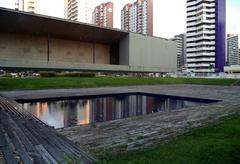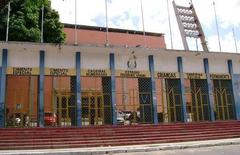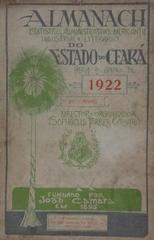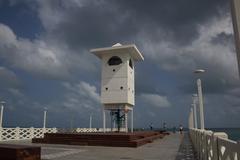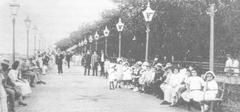Palácio João Brígido Visiting Hours, Tickets, and Historical Site Guide in Fortaleza, Brazil
Date: 04/07/2025
Introduction to Palácio João Brígido and Its Significance
Palácio João Brígido, also referred to as Palácio do Bispo, is a cornerstone of Fortaleza’s historical and cultural landscape. Located in the city’s historic center, this neoclassical structure was constructed between the late 19th and early 20th centuries, originally serving as the official residence of the Bishop of Fortaleza. Its monumental design, featuring stately columns, arched windows, and intricate details, reflects the influential role of the Catholic Church during a transformative period in Ceará’s capital. Over time, the palace transitioned from its religious origins to become a dynamic civic and cultural hub, mirroring Fortaleza’s growth and evolving identity.
Today, Palácio João Brígido is home to the Memorial do Paço, a cultural center dedicated to preserving and showcasing Fortaleza’s indigenous, colonial, and political narratives. Its central location, near landmarks like the Metropolitan Cathedral and Praça do Ferreira, makes it a pivotal destination for anyone seeking to immerse themselves in the city’s heritage. With free admission, accessible facilities, and a variety of guided tours and educational activities, the palace welcomes visitors of all backgrounds to explore Ceará’s past and present. For in-depth historical insights and visitor updates, consult Fortaleza Nobre and O Povo.
Table of Contents
- Introduction
- Origins and Construction
- Historical Role and Evolution
- Cultural and Community Impact
- Preservation and Modern Relevance
- Visitor Information
- Visitor Tips
- Nearby Attractions
- Visuals and Media
- Frequently Asked Questions (FAQ)
- Conclusion and Call to Action
- References
Origins and Construction
Palácio João Brígido was designed as the official residence of the Bishop of Fortaleza, embodying the Catholic Church’s expanding influence during a time of urban modernization. Its architectural style fuses neoclassical and baroque elements, with a symmetrical façade, grand columns, and decorative cornices. Situated next to the city’s main cathedral, the building was both a spiritual and civic anchor in Fortaleza (Fortaleza Nobre).
Historical Role and Evolution
Ecclesiastical and Political Influence
Initially, Palácio João Brígido functioned as a vital center for ecclesiastical administration, hosting important religious and civic events. Its proximity to the cathedral facilitated coordination of liturgical celebrations and diocesan affairs. Over the years, the palace also became a venue for political discussions, social initiatives, and community gatherings, shaping the trajectory of Fortaleza’s development.
Architectural Legacy
The palace stands as an outstanding example of Fortaleza’s historical architecture. Restoration and conservation projects have preserved its original features, including stucco work, wrought-iron balconies, and decorative ceilings. The building’s architectural integrity has influenced subsequent civic projects in the city (O Povo).
Cultural and Community Impact
Educational Programs
Palácio João Brígido now serves as a vibrant cultural venue. The Memorial do Paço offers exhibitions, art shows, and historical retrospectives. Guided tours, educational workshops, and interactive learning experiences foster appreciation for Fortaleza’s history among students and tourists.
Symbol of Civic Identity
The palace has become a symbol of Fortaleza’s resilience and collective memory. Its location and architectural prominence make it central to public life, hosting ceremonies and cultural celebrations that reinforce a sense of community identity (Fortaleza Nobre).
Preservation and Modern Relevance
Heritage Protection
Recognized as a protected heritage site, Palácio João Brígido is the focus of ongoing conservation efforts. Restoration projects maintain its historical integrity while adapting the space for public use. Collaboration between heritage organizations and government agencies ensures the palace remains a preserved landmark.
Urban Integration
Strategically positioned within Fortaleza’s historic core, the palace anchors urban development, balancing tradition with modernization. Its influence is visible in the design of neighboring civic structures, and its integration with the city’s cultural circuit stimulates revitalization in the surrounding area.
Visitor Information
Visiting Hours
- Palácio João Brígido: Monday to Friday, 8:00 AM – 5:00 PM (Tapis Rouge)
- Memorial do Paço: Tuesday to Friday, 9:00 AM – 5:00 PM; Saturday, 10:00 AM – 4:00 PM (closed Sundays and Mondays) (Opinião CE)
Tickets and Admission
Admission to both the palace and the Memorial do Paço is free. Some special exhibitions or events may require tickets or prior registration; check the official Fortaleza City Hall website for updates.
Accessibility
Palácio João Brígido is fully accessible, featuring ramps, adapted restrooms, tactile flooring, and digital aids (such as QR codes with audio descriptions) for visitors with visual or hearing impairments (Tapis Rouge).
Location and Transportation
Address: Rua São José, 01, Centro, Fortaleza, Ceará, CEP 60060-170. The palace is easily accessible by public transportation, with multiple bus lines and street parking nearby. The surrounding area is walkable and close to other major attractions (Mapa Cultural Ceará).
Visitor Tips
- Language: Portuguese is the primary language; some digital content is available in English. Basic Portuguese phrases are helpful (Traveling Lifestyle).
- Dress Code: Modest attire is recommended, especially during religious or official events.
- Photography: Allowed in most areas, except where restricted.
- Climate: Fortaleza is tropical; wear light clothing and stay hydrated.
- Safety: The area is safe during the day; standard urban precautions are advised after dark.
Nearby Attractions
- Metropolitan Cathedral of Fortaleza: Neo-Gothic architecture and city views.
- Praça do Ferreira: Central square with historic buildings, cafes, and shops.
- Central Market: Handicrafts and local food stalls.
- Dragão do Mar Center of Art and Culture: Museums and galleries.
Visuals and Media
Browse high-quality images and virtual tours of Palácio João Brígido and its exhibitions on the official city website. Optimized images with descriptive alt text, such as “Neoclassical façade of Palácio João Brígido in Fortaleza,” enhance both accessibility and user experience.
Frequently Asked Questions (FAQ)
Q: What are the Palácio João Brígido visiting hours?
A: Monday to Friday, 8:00 AM – 5:00 PM.
Q: Is admission free?
A: Yes, both the palace and its exhibitions are free to enter. Some special events may require tickets.
Q: Are guided tours offered?
A: Yes, especially for groups and schools. Self-guided tours are supported by QR codes.
Q: Is the palace accessible for visitors with disabilities?
A: Yes, it features ramps, accessible restrooms, tactile flooring, and digital aids.
Q: Can I take photographs?
A: Photography is permitted in most areas; please respect signage where restrictions apply.
Q: Are restrooms and amenities available?
A: Restrooms and water fountains are on site. Dining options are available nearby.
Conclusion and Call to Action
Palácio João Brígido is an essential destination for understanding Fortaleza’s history, architecture, and cultural evolution. Its accessible facilities, engaging exhibitions, and central location make it ideal for both locals and visitors. To enrich your experience, download the Audiala app for guided tours, maps, and exclusive content, and follow the palace’s official channels for the latest news and events. Plan your visit and discover why Palácio João Brígido remains a beacon of Fortaleza’s heritage.
